Lotus: art in Dir en grey
A classic tale of east meets west, young woman meets life, and Brabant gets good exposure.

In this little write-up on Lotusís art, Iíll relate on the works, their meaning and significance, but also on the act of hunting. This is the second large-scale image hunt Iíve performed - the first one was after I fell hopelessly in love with the 1999 Sierra game Gabriel Knight 3: Blood Of The Sacred, Blood Of The Damned (this mouthful will be referred to as GK3 in the rest of the text). That search took place in 2009. Playing GK3 was the most intense experience I ever had with an adventure game - the gripping story that you just canít put down, the awesome interface, the recreation of a world, the luxurious settings, the wonderful musicÖ At one point thereís just little more to discover and I had to put it down. So I decided to try and identify the pictures, just so I could play a bit longer. With Lotus, itís a different story. Although I really love Dir en grey, the main reason for the identification process was the combination of Hard Rock Band In A Far Away Country and The Painter From Home. Hieronymus Bosch is one of the most beloved painters of my province Brabant, along with Vincent van Gogh. I very much admire his juxtaposition of nightmares, his fantastic creatures and the joy he puts in his work. Itís wonderful to see Bosch and Dir en grey come together. Initially I just wanted to point out the Bosch paintings, but the ball got rolling, and before I knew it I had browsed all of Olgaís Gallery.
There are several differences between the GK3 hunt and the Lotus-hunt that I like to elaborate on. Five years ago, the search engine Google already had its image specific search, but it had failed to deliver. As numerous gamers experienced whilst looking for a specific painting in GK3 of a woman with a red umbrella - while the engine produced thousands of all sorts of pictures of red umbrellas, none of them were the right one. I set out to the library primarily to find this specific image. It wasnít until the fourth big impressionist book that I found it, and Iíd almost lost hope, but then you turn the page and itís there! A fantastic feeling! So, there was GoogleÖ but it wasnít always effective. It was useful when I looked for a painting of a skull and a candlestick, which turned out to be Still Life With Skull And Candlestick by Cťzanne. It was not useful on the many portraits and landscapes.
Fortunately I had the library access, and I could get most of the impressionist paintings out of the books there. On the WWW you can also find websites devoted to great masters like Monet, Degas, Cťzanne and Caillebotte. But in the case of one painting, I knew it had to be a Cťzanne, but I couldnít find it among the 200+ Cťzannes on his art page. Eventually somebody who knew it named it for me. The same goes for a few images of ballerinas by Degas - the man had hundreds of dancer pastels and paintings: just try to find a specific one in the bunch. Eventually I caught it by browsing a major monography in the bookstore. So, back in the day, the main sources were:
-Library
-Bookstores
-Internet galleries
-Other people
Nowadays, youíd think little had changed. On the contrary. After major budget cuts, the large Eindhoven library with the 5-shelf book cases dispersed over 2 floors, became a bare bones library with 3-shelf book cases on the first floor and a large cafe eating up space. The CDs are gone, the DVDs are severely downsized, the games are gone, the sheet music is gone, and other collections have been scaled down. There are art books left, yes, but itís much more limited. And thatís a problem. Not to mention the near disappearance of bookstores: the major second-hand book chain and classy book store chain merged, then went bankrupt to leave a large void. Poor books, out of the window.
Oddly itís a lot easier to recognize a picture from a book, than from a computer. I know I browsed past three of the National Gallery paintings that were the ones I was looking for: when I saw them at the guide in the library, I could see them. Internet galleries are wonderful, but as they are all volunteer work, not a single one of them is complete or entirely usable. Wikimedia Commons, WikiGallery and WikiArt rely on users to add paintings to categories - the amount of paintings on there is a lot larger and less manageable than desired. Clicking on the ďAngelsĒ subject doesnít nearly give you all pictures of angels, for instance. And then thereís my hunt for the Male Nude In Art that left me scarred for life.

Thereís an odd construction in Wikimedia Commons. There is a division of painters by movement and by country, so you can look for Renaissance painters in Italy. Convenient. But for whatever reason, The Netherlands is not included in the movement sorting. With The Netherlands being a major producer of the fine arts, that is a serious issue. Why arenít we included with the baroque painters? The complete opposite but equally annoying thing happens in the section of frescoes. The Dutch Artist category is one that started out small, but grew enormous, leaving a few bulky sections and a large unsorted category. The German frescoes have a strictly organized tree with many branches, but next to no leaves. Say: youíre looking for 18th century frescoes. You click on the 18th Century Fresco tab, then on the 18th Century German Fresco tab, then on the 1730s German Fresco tab, then on the 1737 German Fresco tab, then on the 1737 German Frescoes From Baden-WŁrtembergÖ and youíll only find one picture there. The subdivisions would be handy if there were hundreds of frescoes to choose from, but in reality there just arenít any 1737 German frescoes that aren't from Baden-WŁrtemberg. You keep clicking on links before you can find one picture - and then that picture is not the right one. The Dutch section started off to small and is bursting at the seams, the German is like a concert hall prepared to host a free Lady Gaga show, but that has one down-on-his-luck accordeonist playing Besame Mucho over and over on stage.
It was clumsy, but I managed to check every single one of the painters in the Renaissance, Baroque, Mannerist, Neo-Classical and Rococo era of Wikimedia Commons. And didnít find it. In all I checked over 30,000 pictures looking for these 7 pictures. Luckily itís a labour of love.
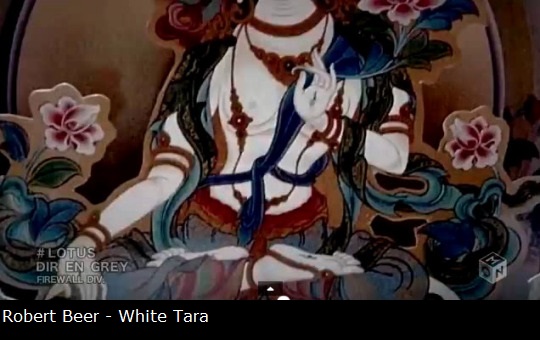
Google Visual Images was a very useful tool in finding the Robert Beer-painting. Iím not familiar with the Buddhist pantheon and didnít know what I was looking at, so it was a bit of luck that Google Images found the picture it came from, just from that fragment. It comes out of a pop-up book by Robert Beer. If you look at the PV picture, you can see the shadows on the back paper.

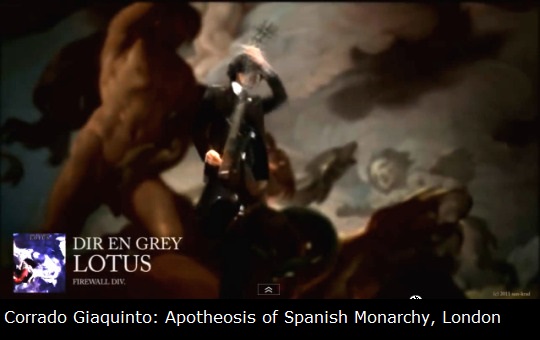
Google Visual tends to work by picture format and by colour. By adding search terms, you can try to steer it in the right direction. Whenever I used a screencap called Lotus, itíd immediately link me to the Diru video. Even after renaming them, Iíd still get there over the logo at the bottom. Even looking for a fragment wouldnít help: I could see that the dark images were really blue, but the search engine interpreted them as black. For some reason, when I entered a lighter and cropped (to remove the Lotus text at the bottom) version of the fresco screenshot with the beautiful Toshiya, resulted in a picture of Ecce Mono, that fresco an elderly Italian woman ďrestoredĒ. Ö Ö his eyeliner wasnít that thickÖ But the final two pictures Iíd searched all of Wikimedia Commons forÖ I eventually found with Google Visual. After aeons of searching Commons and finally resigning to the fact that it wasnít going to be on there, I went to try the search engine with the one picture I hadnít tried in cropped and bright version. And what do you know? It brought me exactly to where I needed to be. Days of searching in vain. Tsk. Oh well! I found itís Apotheosis of the Spanish Monarchy, by Giaquinto.
At two points I browsed through the entire National Gallery online collection, but that didnít find me anything. All the weirder that there are five pictures I shouldíve been able to find that way.
 The first of these was a floral still life by Balthasar van der Ast. I could tell there was a tulip at an unusual angle, and a rose. However, floral still lifes were extremely popular with the audiences (artist appreciation of the ďart femininĒ was low). The pictures sold very well, and so a lot were made. Painters like Rachel Ruysch produced tons of them, all different enough to tell them apart after a brief study, but all similar enough to make a Floral Still Life overview extremely boring. Thousands of bouquets were made, particularly in the 17th century with the tulip craze. Not to mention that flowers were one of the very few subjects that were considered bon ton for women to make. It was not allowed for female artists to attend model drawing sessions, and drawing historical scenes, religious or mythological scenes, especially nudes, was not done: women with aspirations in the art field who were even allowed to follow an education, would usually be limited to this subject.
The first of these was a floral still life by Balthasar van der Ast. I could tell there was a tulip at an unusual angle, and a rose. However, floral still lifes were extremely popular with the audiences (artist appreciation of the ďart femininĒ was low). The pictures sold very well, and so a lot were made. Painters like Rachel Ruysch produced tons of them, all different enough to tell them apart after a brief study, but all similar enough to make a Floral Still Life overview extremely boring. Thousands of bouquets were made, particularly in the 17th century with the tulip craze. Not to mention that flowers were one of the very few subjects that were considered bon ton for women to make. It was not allowed for female artists to attend model drawing sessions, and drawing historical scenes, religious or mythological scenes, especially nudes, was not done: women with aspirations in the art field who were even allowed to follow an education, would usually be limited to this subject.
The two hints in the image were the tulip and the rose: neither flower is particularly rare in the field of Floral Still Life Subject. What is notable is that the tulip is at a horizontal angle. With just the tulip and rose and their relative positions to go by, I couldn't find them. Until I discovered the HD version of Lotus.
When I watched that, all of a sudden, a yellow flower with a spider on it appeared. With the aid of that little spider I found it rather quickly. Öof course, not after checking the complete oeuvres of many floral still life specialists.
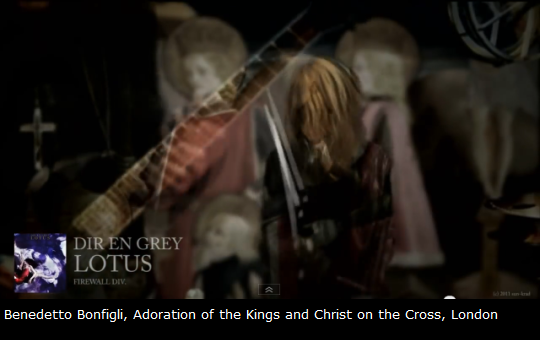
Another HD find was in the Three Kings - Crucifixion scene. Like the Floral Still Life and the Madonna, I also missed this one on the National Gallery before I found it. Initially, once Iíd noticed the haloes, it gave me a time frame. When perspective was introduced, it became increasingly hard for artists to find a way to draw convincing haloes around the saintsí heads. They werenít disbanded altogether, you can still find them in the Pre-Raphaelite school and in Russian Orthodox art up to the 1900s, but these haloes signified it was probably made before 1600. I couldnít tell whether the two prominent characters were male or female. I could tell, however, that they wear crowns. A short search led me to believe that these were saints Catherine and Elizabeth, since they both were crowns. Had I seen that the third character at the bottom also had one (heís taken off his to make a reverence to baby Jesus), I mightíve made the connection with the Three Kings earlier. Anyway, after the HD screencap, I noticed a figure with a cross on the right hand side. And so, after manually checking all the little Giotto and Fra Angelico pictures of many many saints for the exact position, I just entered ďcrucifixionĒ on the National Gallery siteÖ and got this. The Adoration Of The Kings And Christ On The Cross is a decidedly creepy painting. Nascento morimur - from birth to death - was a popular theme in Flanders and Germany in the 16th century. They usually show a cute chubby baby lying on a skull. This painting, however, appears to be from Italy: and it predates the other nascento morimurs by a century. The faces look reasonably refined - Joseph looks considerably older than Maria. Also mesmerising is the king who I mistook for St Catherine, as the black collar made me believe it could be a convent outfit. And what to think of the blood trail running down from Jesusís feet?
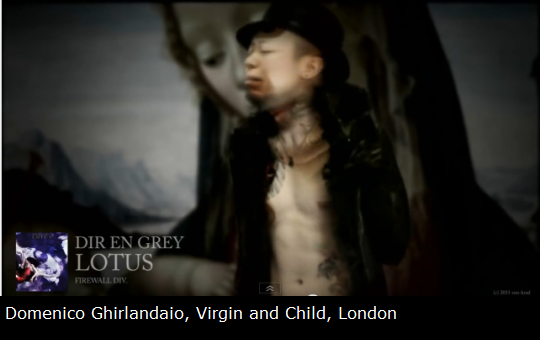
One that was easy to interpret was the Madonna and Child by Ghirlandaio. Madonna and child is another highly popular subject: the universal image of mother and child charms, I suppose. The Guirlandaio painting also illustrates the problem of the haloes: it looks a bit like the neighborhood kids are playing with those toy helicopters, you know, those little propellors that you spin and they fly away? Clues to finding it are the direction in which Madonna looks, the baby arm and the mountain background. The colours are off in the entire video. I was surprised at how bright the Ghirlandaio looks.
Strangely I recognized this one instantly from the book, but I didn't pick up on it while I was browsing the site. This could be search fatigue: the phenomenon that, while searching, you will forget what you were looking for. This can be helped by repeating the name of the missing object. Saying "Madonna and Child from the renaissance era with Madonna looking left and down, a mountain range on the background and a baby arm on her chest"... that doesn't really work though.
Hopefully this illustrates the difficulties I experienced with interpreting the dark pictures. A better tactic is to look for the great lines, which worked great on the Roberti.

As I was reaching the end of my search and only had three paintings to go, there was only one that would be from the Renaissance era. The dead give-away was the Character With Silly Red Hat. Red hats pop up throughout paintings between 1450 and 1550, many painters portraitted themselves with one. I could not find any other significance to them in symbolism, so I suppose it was a status of wealth. Red was one of the most expensive colours to make cloth dye for. The other thing to look for was the highly geometric structure on the background. The pillars truly indicate depth. It was this construction that made me find it, eventually, after checking all the Renaissance painters, ending with the category Italian Renaissance Painters, all the way up to R. The image is part of the Griffioni predella. It was made by Ercole deíRoberti, and depicts the miracles of St Vincent Ferrer, a 14th century monk whoís the patron saint of builders. The artist Deíroberti is an interesting subject. He was very fond of alcohol and died young of apoplexy as a result. The picture has been removed from the original altar and is now at the Pinacoteca in the Vatican.

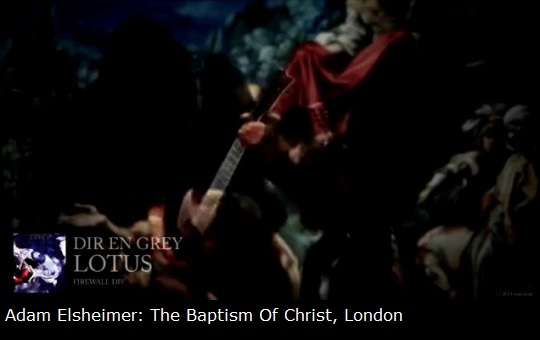

The National Galleryís very prominent, with 6 paintings on show in the video: the Madonna, the floral still life, the three kings, the apotheosis, the Elsheimer and the Bronzino. Elsheimer was easily found. I had a picture of it in my newspaper clippings scrapbook. However I was so focused on the angels, that I didnít notice other sections of it were also being used. On those pictures with Die, all I noticed was a character with unusual headgear - something similar to what Pilate wears on a Bosch painting. I did spend an hour or so looking for images of Pilate that matched. Elsheimerís primarily known for his Flight to Egypt. He didnít get to be very old, and due to this, his perfectionism and depressions his oeuvre is very small, but he was very innovative in his use of lighting and landscapes and was an influence to many major Northern artists, like Rembrandt and Rubens. In Baptism of Christ, you can see the light is coming from the sky and runs between the four angels - the prominent front right figure is very dark, adding extra depth.
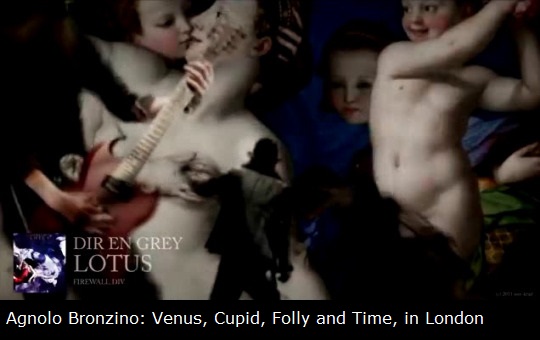
Thereís one other National Gallery painting: the Allegory of Venus and Cupid, by Angelo Bronzino, with the beautiful blue. Itís an allegorical painting with a lot of symbolism that a tour guide talked my class through on our field trip to London. Venus and Cupid are having a wonderful time while the cheeky Folly is strewing roses - but the roses have thorns. The woman with the pretty face behind Folly is tempting with honey, but sheís a half serpent, ready to poison. The masks, and God of Time Cronos pulls back a cloth, as a reminder that itís all a stage, and itís all temporary. The mesmerising figure behind the couple, at the left of the painting, has been interpreted as either Jealousy or as suffering from syphilis. No, donít laugh, syphilis was a black spot before the discovery of penicilin, it has been around in Europe since the crew of Columbus brought it back with them from their trip to the Americas. The first major outbreak in Europe was in Naples in 1495, and the disease was already featured in sketches by DŁrer. The painting is taken to have the following message: enjoy love, but beware of the dangers. Whether there is any significance to Kyo holding his hand over Venusís breast and Die being at the place of the Syphilis character, I like to leave that at the interpretation of the reader.
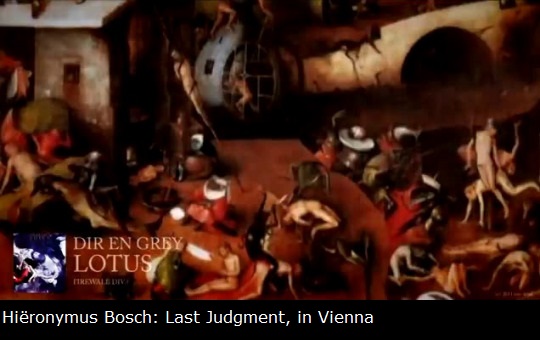
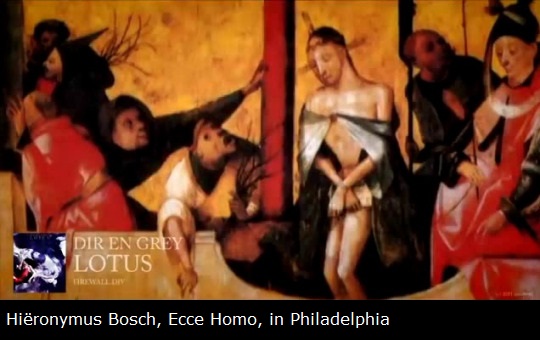
 The most prominently represented painter is the aforementioned HiŽronymus Bosch. Bosch was the third son of painter Anthonis van Aken, born around 1450 in the town which name he would adopt, Ďs-Hertogenbosch (also known as Den Bosch). Not much is known about him, except he probably witnessed the great fire of his home town in 1463 - many of his paintings feature burning cities. He was already a painter when in 1481 he was assigned to paint two panels of an altar piece, intended for the altar of the majestic St Johnís cathedral. He married into wealth in 1481: early on his wife had to sell some of her land to survive, but later on, Bosch became successful enough to lend money himself. He joined a prominent religious brotherhood in 1486 and started using his pseudonym around 1490. By the turn of the century he was well-known: in 1503 he was given the assignment for The Last Judgment by Philip I of Castilia. His fame stretched to the cardinal of Vienna. He passed away in 1516, as a ďseer vermaerd schilderĒ, a very famous painter. It took a while for artists to follow in his footsteps, but Herri met de Bles, Jan Mandijn and most notably Pieter Bruegel Sr follow the same style of the absurd. In later times, you can find his influence in the works of surrealists like DalŪ and Max Ernst. Boschís works feature an old-fashioned, even for his day, high horizon, a multitude of human characters in a bad world of sin, bizarre creatures and course work. He is beloved for his imaginative creatures.
The most prominently represented painter is the aforementioned HiŽronymus Bosch. Bosch was the third son of painter Anthonis van Aken, born around 1450 in the town which name he would adopt, Ďs-Hertogenbosch (also known as Den Bosch). Not much is known about him, except he probably witnessed the great fire of his home town in 1463 - many of his paintings feature burning cities. He was already a painter when in 1481 he was assigned to paint two panels of an altar piece, intended for the altar of the majestic St Johnís cathedral. He married into wealth in 1481: early on his wife had to sell some of her land to survive, but later on, Bosch became successful enough to lend money himself. He joined a prominent religious brotherhood in 1486 and started using his pseudonym around 1490. By the turn of the century he was well-known: in 1503 he was given the assignment for The Last Judgment by Philip I of Castilia. His fame stretched to the cardinal of Vienna. He passed away in 1516, as a ďseer vermaerd schilderĒ, a very famous painter. It took a while for artists to follow in his footsteps, but Herri met de Bles, Jan Mandijn and most notably Pieter Bruegel Sr follow the same style of the absurd. In later times, you can find his influence in the works of surrealists like DalŪ and Max Ernst. Boschís works feature an old-fashioned, even for his day, high horizon, a multitude of human characters in a bad world of sin, bizarre creatures and course work. He is beloved for his imaginative creatures.
The Garden Of Delights tryptich (a section of which flashes by) shows many naked people, riding huge animals, massive birds, buildings that look like creatures and animals that look like beasts. A person is eaten by a giant mussel. A cornucopia of food and love. To the right of this panel is the painting colloquially known ďMusicianís HellĒ, and Iíll admit to some disappointment that this panel wasnít used in the video.

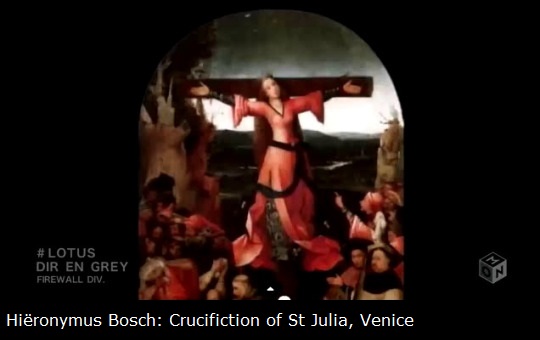
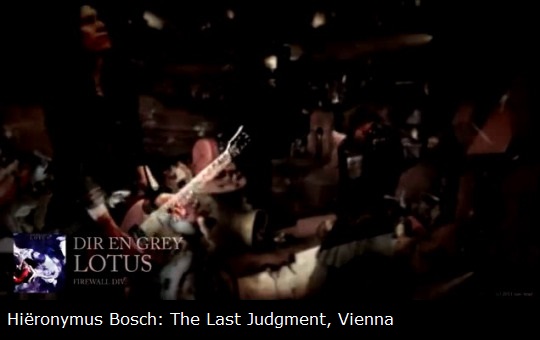
The Haywain tryptich is probably a copy of a lost original. The left panel shows Adam and Eve, the middle panel shows sinners, the right panel shows the hell. A small sinners section flashes by in Lotus: not long enough to spot the fighting thugs, the couple with the baby doing who-knows-what, the treacherers and the bagpipe players. Back in the day, the bagpipes were a symbol for the female organs. The Last Judgment (the one currently in Vienna) is also a tryptich showing paradise, sin and hell. The sinners section is used twice, once in a short flash and once beside Die. The Martyrdom of St Julia, woman on a cross, zips by. The last tryptich in the video is The Temptation Of St Anthony, currently in Lisbon. The middle panel depicts the various temptations like luxury that the saint faces, and his refusing them.
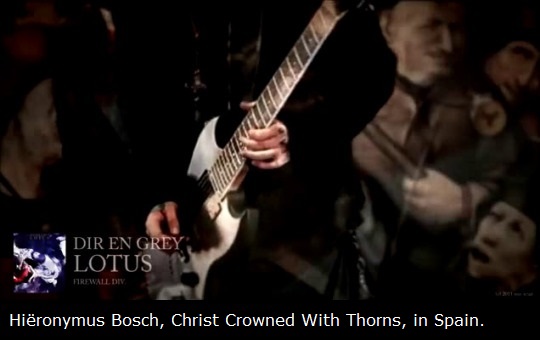
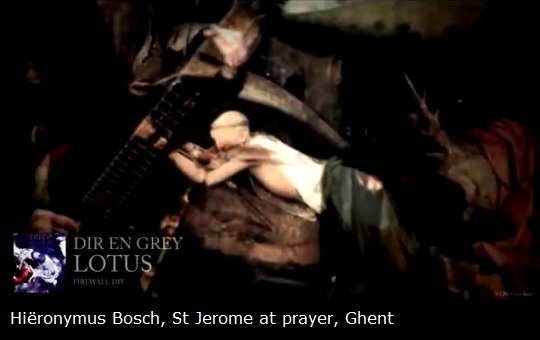

Visions Of The Hereafter has four panels, each depicting one aspect of life beyond death. A green reptile-like demon torturing a victim appears behind Shinya. The Christ Carrying The Cross (from Vienna) appears briefly. The lower men talking to each other. Christ Crowned With Thorns (from Escorial) is shown behind Kaoru. In these paintings you can see how expressive Bosch got with the faces of his characters. Ecce Homo (Philadelphia) also zips by. Itís believed by some to be by a late 16th century follower. St Jerome, who made the Vulgate translation, was a very popular subject in the Renaissance. His position, lying down with a crucifix in his arms, is an unusual position for a praying man.
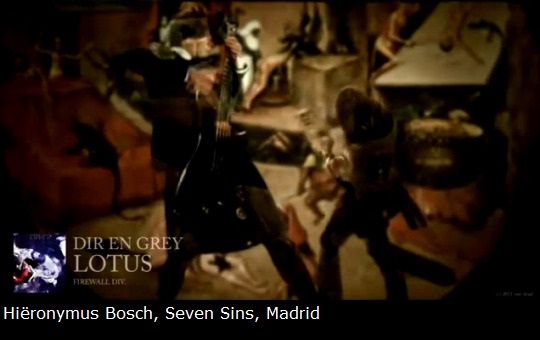
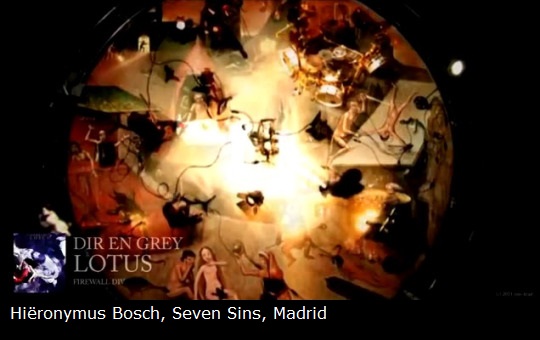
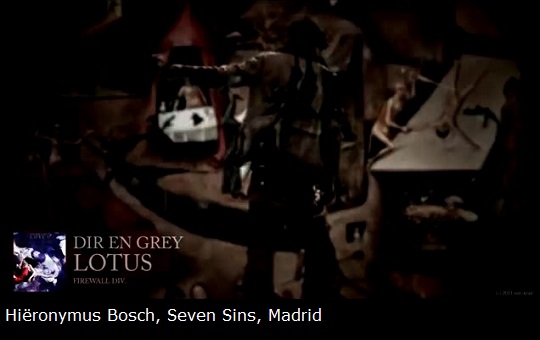
Seven Deadly Sins And Four Last Things is very prominent in the video: besides being used three times, itís the only projection shown in the overhead shot. The table top center displays seven scenes of the different sins: a woman in front of a mirror held up by a demon, a man and child overfeeding themselvesÖ In one of the four corners you can find the Hell thatís used in the video. A demon cuts open a man on a tilted table, that hangs over a cauldron with boiling pitch and sinners, a man is forced to eat worms and toads, a woman spanks a naked man with a hammer, demons pull a loving couple out of bedÖ In the background people are torn apart by dogs. The image shows the names of the sins the people are punished for: luxuria (lust or luxury), ira (anger), superbia (pride), gula (gluttony), avaricia (greed), invidia (envy).
It is notable that most paintings feature Christian mythology. Distilling the religions of Diruís members is not a task Iíd like to attempt, but lyrics like Red ĎEm and Jesus Christ R&R donít really make one believe these people are devoted catholics. Kaoru does wear a major crucifix, yet most of the people sporting a cross here wouldnít have one with an actual dying Jesus on it. Lotusís lyrics - it will take another few years of learning Japanese before I might dare to attempt to interpret them - one interpretation Iíve read with interest is that Kyo writes about his tattoos, notably the one of Buddhist goddess of mercy Kannon on his back.
In the process of viewing tens of thousands of images, I learnt a lot about art, christian tradition and syphilis. I learnt what it would take to make the perfect art gallery. I learnt again how much fun it is to be working this intensively with the fine arts. My wish for all those who read this, is that they look up art books (if lacking, Wikipedia is complete on the artist) on HiŽronymus Bosch, that they can soak up all the details of the fantastic world he created. Unless you work at the National Gallery, in which case I hope you put larger thumbnails in your web gallery.
List Of Images From Lotus:
- Corrado Giaquinto - Apotheosis of the Spanish Monarchy
- Ercole deíroberti: The Miracle of St Vincenzo Ferrer
- Domenico Ghirlandaio - Virgin and Child
- Benedetto Bonfigli (attributed) - The Adoration Of The Kings And Christ On The Cross
- Balthasar van der Ast - Flowers In A Vase With Shells And Insects
- Alan Elsheimer - The Baptism Of Christ
- Robert Beer - White Tara
- Angelo Bronzino - Allegory of Venus and Cupid
- HiŽronymus Bosch - Christ Carrying The Cross(Vienna)
- HiŽronymus Bosch - St Jerome At Prayer
- HiŽronymus Bosch - Christ Crowned With Thorns (Escorial)
- HiŽronymus Bosch - Hell
- HiŽronymus Bosch - Seven Deadly Sins and the Four Last Things
- HiŽronymus Bosch - Cricifixion of St Julia
- HiŽronymus Bosch - Temptation of St Anthony (Lisbon)
- HiŽronymus Bosch - Garden of Earthly Delights
- HiŽronymus Bosch - Ecce Homo (Philadelphia)
- HiŽronymus Bosch - Last Judgment (Vienna)
- HiŽronymus Bosch - Haywain
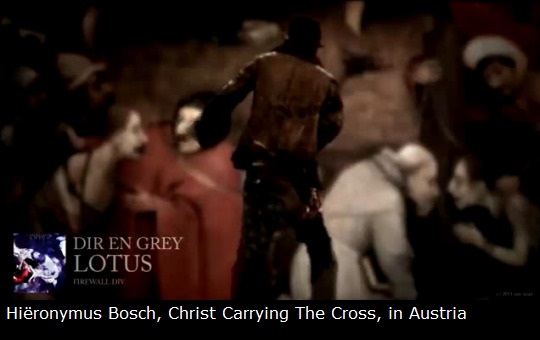
LINKS
HiŽronymus Bosch on Wikipedia
Website of National Gallery London
Robert Beer official site
Ercole de'Roberti on Wikipedia
WikiGallery
Dir en grey's official site
BACK TO TEXT
BACK TO HOME





 The first of these was a floral still life by Balthasar van der Ast. I could tell there was a tulip at an unusual angle, and a rose. However, floral still lifes were extremely popular with the audiences (artist appreciation of the ďart femininĒ was low). The pictures sold very well, and so a lot were made. Painters like Rachel Ruysch produced tons of them, all different enough to tell them apart after a brief study, but all similar enough to make a Floral Still Life overview extremely boring. Thousands of bouquets were made, particularly in the 17th century with the tulip craze. Not to mention that flowers were one of the very few subjects that were considered bon ton for women to make. It was not allowed for female artists to attend model drawing sessions, and drawing historical scenes, religious or mythological scenes, especially nudes, was not done: women with aspirations in the art field who were even allowed to follow an education, would usually be limited to this subject.
The first of these was a floral still life by Balthasar van der Ast. I could tell there was a tulip at an unusual angle, and a rose. However, floral still lifes were extremely popular with the audiences (artist appreciation of the ďart femininĒ was low). The pictures sold very well, and so a lot were made. Painters like Rachel Ruysch produced tons of them, all different enough to tell them apart after a brief study, but all similar enough to make a Floral Still Life overview extremely boring. Thousands of bouquets were made, particularly in the 17th century with the tulip craze. Not to mention that flowers were one of the very few subjects that were considered bon ton for women to make. It was not allowed for female artists to attend model drawing sessions, and drawing historical scenes, religious or mythological scenes, especially nudes, was not done: women with aspirations in the art field who were even allowed to follow an education, would usually be limited to this subject.








 The most prominently represented painter is the aforementioned HiŽronymus Bosch. Bosch was the third son of painter Anthonis van Aken, born around 1450 in the town which name he would adopt, Ďs-Hertogenbosch (also known as Den Bosch). Not much is known about him, except he probably witnessed the great fire of his home town in 1463 - many of his paintings feature burning cities. He was already a painter when in 1481 he was assigned to paint two panels of an altar piece, intended for the altar of the majestic St Johnís cathedral. He married into wealth in 1481: early on his wife had to sell some of her land to survive, but later on, Bosch became successful enough to lend money himself. He joined a prominent religious brotherhood in 1486 and started using his pseudonym around 1490. By the turn of the century he was well-known: in 1503 he was given the assignment for The Last Judgment by Philip I of Castilia. His fame stretched to the cardinal of Vienna. He passed away in 1516, as a ďseer vermaerd schilderĒ, a very famous painter. It took a while for artists to follow in his footsteps, but Herri met de Bles, Jan Mandijn and most notably Pieter Bruegel Sr follow the same style of the absurd. In later times, you can find his influence in the works of surrealists like DalŪ and Max Ernst. Boschís works feature an old-fashioned, even for his day, high horizon, a multitude of human characters in a bad world of sin, bizarre creatures and course work. He is beloved for his imaginative creatures.
The most prominently represented painter is the aforementioned HiŽronymus Bosch. Bosch was the third son of painter Anthonis van Aken, born around 1450 in the town which name he would adopt, Ďs-Hertogenbosch (also known as Den Bosch). Not much is known about him, except he probably witnessed the great fire of his home town in 1463 - many of his paintings feature burning cities. He was already a painter when in 1481 he was assigned to paint two panels of an altar piece, intended for the altar of the majestic St Johnís cathedral. He married into wealth in 1481: early on his wife had to sell some of her land to survive, but later on, Bosch became successful enough to lend money himself. He joined a prominent religious brotherhood in 1486 and started using his pseudonym around 1490. By the turn of the century he was well-known: in 1503 he was given the assignment for The Last Judgment by Philip I of Castilia. His fame stretched to the cardinal of Vienna. He passed away in 1516, as a ďseer vermaerd schilderĒ, a very famous painter. It took a while for artists to follow in his footsteps, but Herri met de Bles, Jan Mandijn and most notably Pieter Bruegel Sr follow the same style of the absurd. In later times, you can find his influence in the works of surrealists like DalŪ and Max Ernst. Boschís works feature an old-fashioned, even for his day, high horizon, a multitude of human characters in a bad world of sin, bizarre creatures and course work. He is beloved for his imaginative creatures. 








